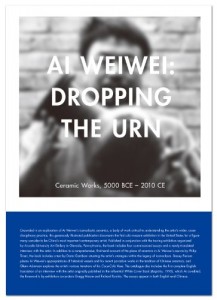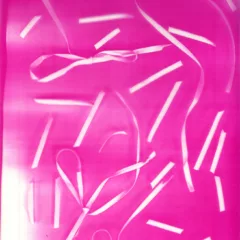This is a superb book worthy of a museum. A catalog of the 2010 exhibit by the same name, the book was produced by little Arcadia University Art Gallery, whose talent always seems to match its ambitions. With 5 essays, a great Q&A with the artist from 1995 and lots of photos, the 125-page book adds a lot to the discussion about the important Chinese dissident artist. Ai Wei Wei, who in his interview speaks in pithy Confucian epigrams, is in fact known almost as much for his writings and dissidence as for his conceptual and epigrammatic art.
Gallery director Richard Torchia and co-author Gregg Moore provide the context for the 2010 exhibit — the first solo exhibit in the US outside New York. They explain Ai’s ambivalent relationship with ceramics, which he uses in his practice but considers a mixed blessing because of the history of Chinese ceramics hanging heavy over his head.
The artist, who lived in the US from 1980-1991 and hates that era of Schnabel/Salle/neo-geo art for its macho posturing, is more of a Minimalist kind of guy, it turns out. And he is a true descendant of Duchamp and Warhol, art’s first conceptual appropriators.
Ai believes that computers, television and information networks have changed humanity forever. We are no longer existing as individuals, he says in 1995, a prescient statement long preceding Facebook, Twitter and other social networks. All the essays in the book, by Torchia and Moore, Philip Tinari, Glenn Adamson, Dario Gamboni and Stacey Pierson bring interesting insights into the making of the artist’s works and their context in contemporary China.
What I love best is interview between the artist and Chinese artist Zhuang Hui in which the artist waxes eloquent on social phenomena as well as artistic. Here’s just a few of the artist’s observations from the interview. Ai, who is deeply in tune with the good and bad of the human condition, has a lot to say about the role of art and the artist in culture.
Self-expression is a way to make humanity advance.
Art’s power is psychological power.
In cultural and psychological subversion is where the power of art lies.
The artist should play the role of virus, like a computer virus.
Most artists are opportunists.
By the way, the exhibit, organized by Arcadia, is traveling. It’s now in Portland, OR at the Museum of Contemporary Craft/Pacific Northwest College of Art, til Oct. 30. After that the show goes to London to the Victoria and Albert Museum where it will be to March 18, 2012.










